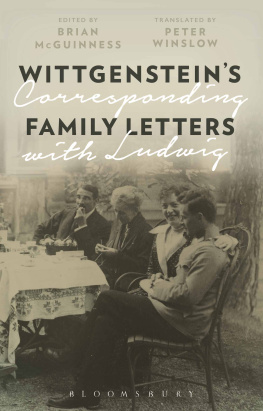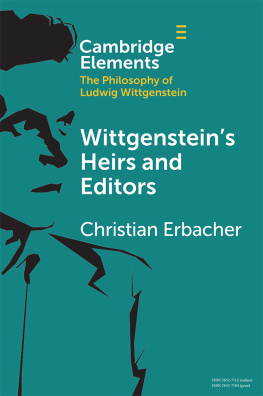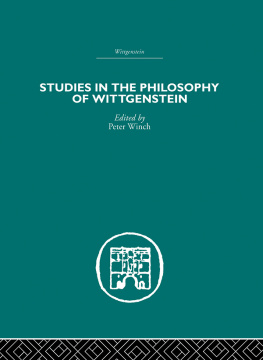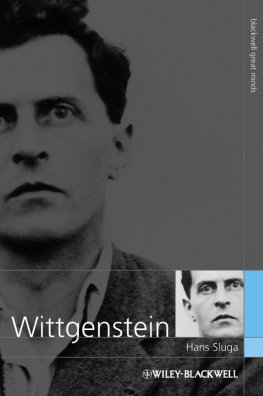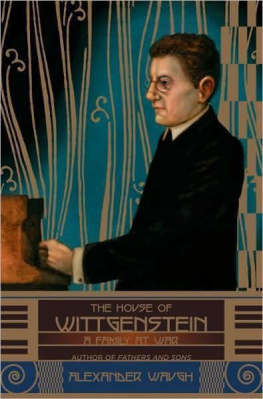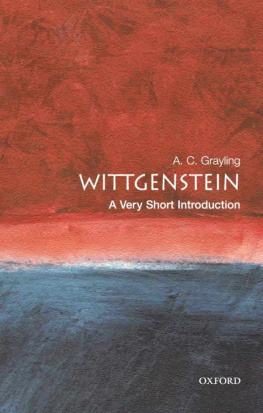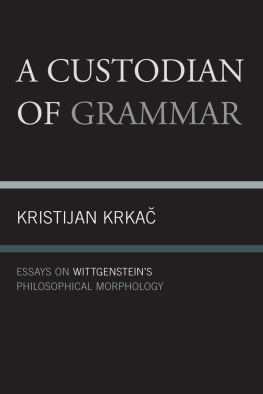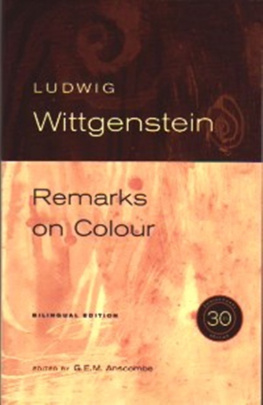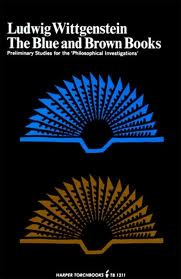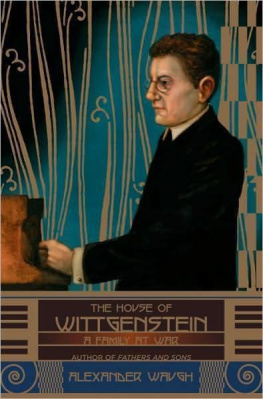
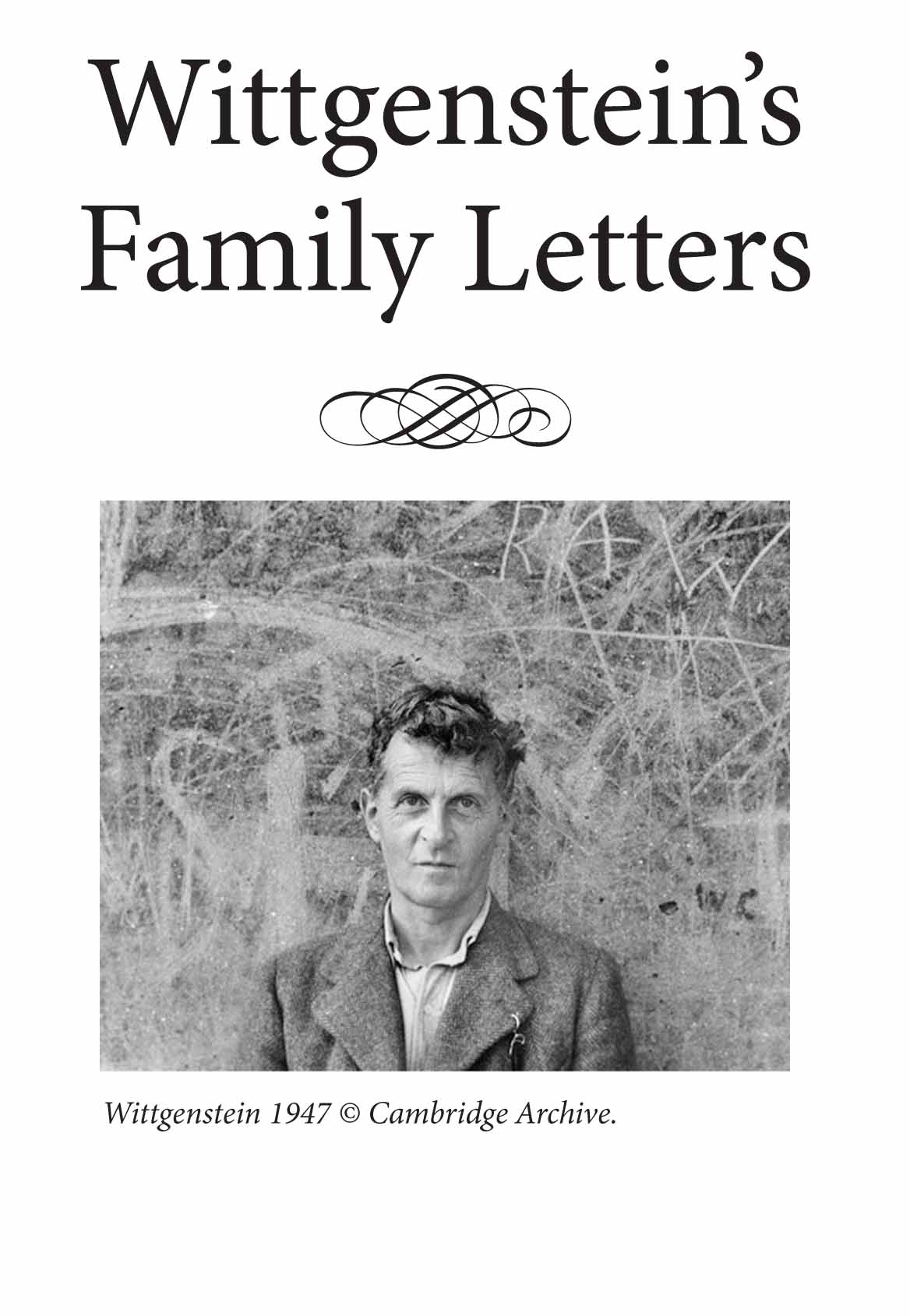
ALSO AVAILABLE FROM BLOOMSBURY
Portraits of Wittgenstein, edited by F. A. Flowers III and Ian Ground
Wittgenstein, Religion and Ethics, edited by Mikel Burley
Dialectic of the Ladder: Wittgenstein, the Tractatus and Modernism, Ben Ware


Contents

Wittgenstein 1947 Cambridge Archive
Seated centre Helene, to her (stage-) left Gretl, at her feet children Ji and Clara The Stonborough Family
Christmas in the Alleegasse, Ludwig the sole diner in informal dress
Margaret, 1920s The Stonborough Family
Portrait of Hermine The Stonborough Family
Ludwig and Paul Cambridge Archive
Ludwig as school master
Letter from Paul to Ludwig, illustrating his use of Kurrentschrift [German cursive] The Brenner-Archiv
The red drawing room at number 16 Alleegasse an impressive 19th century town house, the centre of family activities and used for their musical recitals
Kurt, Paul, Hermine, Max, Leopoldine, Helene, Ludwig Neuwaldegg 1917 The Brenner Archiv
Young Ludwig The Brenner-Archiv
Mariechen Salzer, the favourite niece 1916 [later von Stockert] The Brenner-Archiv
Margaret and (centre) Rudolf Wittgenstein with the brothers Zittkovsky ca. 1900
Leopoldine Wittgenstein, Frau Mama, Alleegasse 1913 The Brenner-Archiv
Josef Labor, the composer The Stonborough Family
Letter from Hermine 7.6.1917 with an inscription (perforce later) by Ludwig: Whereof one cannot talk, thereof one must be silent, which would become the last sentence of the Tractatus (final, printed version: What one cannot speak about with sprechen for reden, wovon for worber.) The Brenner-Archiv
List of manuscripts and typescripts dictated to Hermine by Ludwig in January 1917 attached to her letter of 7 June 1917 The Brenner-Archiv
Copies of the medals won by Ludwig, Bronze and Silver class 2 for valour and Kaiser Karl Soldiers cross. Wittgenstein Initiative, with kind permission by Dr. Martin Pilch. Photo: Bea Laufersweiler
Felix Salzer Lixl, ca. 1911 The Brenner-Archiv
Helene Salzer The Brenner-Archiv
Wittgensteins Military Identity Card
Kurt Wittgenstein ca. 1913. The Brenner-Archiv
Margaret with her sons Tommy and Ji in Swiss exile ca. 1918 The Stonborough Family
Margaret, 1920s The Stonborough Family
Leopoldine & Helene playing four-handed in the Alleegasse The Brenner-Archiv
Marie Baumayer and Hermine The Stonborough Family
Cassino, the town in the 1920s Collezione Mauro Lottici
Cassino, Police Barracks, used as Prisoner of War camp from 1916 Collezione Mauro Lottici
Paul & Mariechen In Silhouette The Stonborough Family
Ludwig with pupils in Lower Austria The Stonborough Family
Ludwig, half-hidden, in drawing room of the Kundmanngasse with (left to right) Marguerite Respinger, Margarete, Head Physician Foltanek, Talla Sjgren (standing), Ludwig apparently asleep on the sofa, Georg Schnborn-Buchheim and Arvid Sjgren. The Stonborough Family
Aunt Claras apartments in Laxenburg castle Wittgenstein Initiative
Music room in Laxenburg Wittgenstein Initiative
Christmas in the Alleegasse The Stonborough Family
Whewells Court, Trinity College Cambridge: Ludwigs room were in the top storey The Stonborough Family
Hermine The Stonborough Family
The family villa in Neuwaldegg The Stonborough Family
Cutting from the Hamburger Illustrierte with statue of Einstein as a saint sent by Paul to Ludwig for his Nonsense collection The Brenner-Archiv
Michael Drobil, Sketch of Ludwig The Stonborough Family
Michael Drobil, Sketch of Ludwig The Stonborough Family
Loquimur Latine cover of handbook send by Paul to Ludwig for his Nonsense collection The Brenner-Archiv
Loquimur Latine extract from a handbook send by Paul to Ludwig for his Nonsense collection The Brenner-Archiv
Max Salzer, Oskar Wollheim, Leopoldine, Alois Hnisch (Seccession artist), Helene, Ludwig, Felix Salzer The Brenner-Archiv
Margaret in New York in the 1940s The Stonborough Family
Margarets wartime apartment in New York The Stonborough Family
Wittgenstein and Von Wright Cambridge Archive
76 Storeys Way, Cambridge, home of Ludwigs doctor where he passed his last months
Death notice issued by Ludwigs family Wittgenstein Initiative

The editor here builds on a previous smaller selection of family letters published in 1996 by Hlder-Pichler-Tempsky Verlag, one of whose principal editors was Frau Maria Ascher Corsetti. She has helped me also with counsel and I thank her in the first place. That edition appeared in the Schriftenreihe der Wittgenstein-Gesellschaft and its current President Dr Friedrich Stadler has been kindly supportive of the appearance of this second extended edition.
Of the family members who at that earlier time provided letters and illustrations alas only Dr Andreas Sjgren survives. He has generously provided yet more material, particularly photographic. I thank Dr Stephan Stockert for the permission to reissue this family correspondence collection and to Dr Florian Stockert for his continuous support and availability to answer questions regarding the family history. I owe a debt to the generosity of Francoise and Pierre Stonborough who have given me free access to their private photo archive. Mr Louis Wittgenstein made available to the Brenner-Archiv in Innsbruck letters exchanged between his father Paul and his uncle Ludwig, a most important addition to this selection. The Brenner-Archiv itself, guided by its director Dr Ulrike Tanzer and two of its senior associates, Professors Allan Janik and Josef Mitterer, has been an invaluable resource. There I could consult the material presented in the Gesamtbriefwechsel (on which I myself have worked, now used by kind permission of electronic publisher InteLex) and have access to Ludwig Wittgensteins Collection of Nonsense, items from which also appear (signalized as such/with due warning) in these pages. For the exploitation of the Archiv I have had the ready assistance of Dr Joseph Wang and Dr Anton Unterkircher. On military matters in particular I have had help from the extremely well-informed Dr Martin Pilch of Vienna. For general control of texts, translation and biography I could not have had better help than that of Dr Joachim Schulte with his unrivalled knowledge of the Ludwig Wittgenstein corpus, help unstintingly given throughout a lifetime. My work would not have been possible without the help of my Siena assistant, dottoressa Mariangela Faso.
This volume has been produced almost in tandem with a German version edited by Frau Radmila Schweitzer of the Wittgenstein-Initiative in Vienna, whom obviously I have constantly consulted. We have both profited much from the exceptional attention that Colleen Coalter of Bloomsbury has devoted to this edition. I am extremely grateful to these ladies. One might say there are here three editors, or four, counting Dr Schulte. In such circumstances it will not be a surprise that our translator, Mr Peter Winslow, has had to show patience as well as persistence in the exceptionally difficult task of producing a colloquial, or rather epistolary, translation. We hope it has turned out well.
Next page
